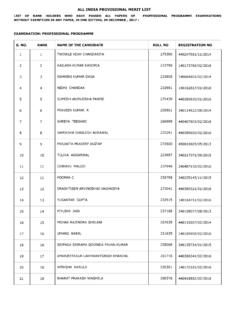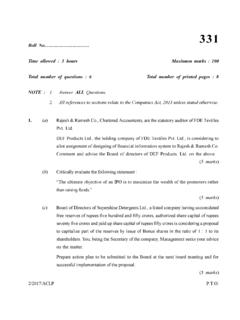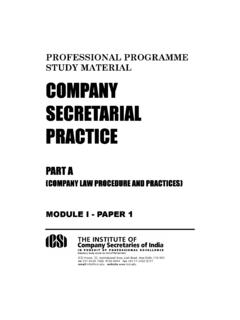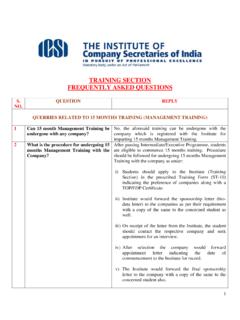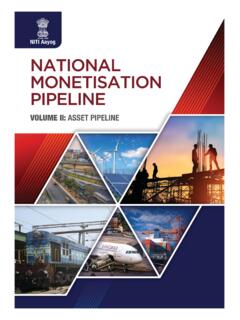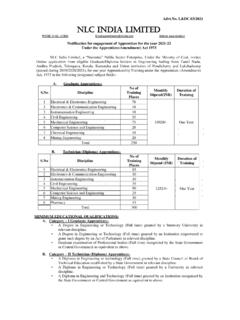Transcription of OIL AND GAS INDUSTRY - ICSI
1 OIL AND GAS INDUSTRYiiAugust 2018 THE INSTITUTE OF COMPANY SECRETARIES OF INDIAD isclaimerDue care has been taken to avoid errors or omissions in this publication. In spite of this, errors may still persist. Any mistake, error or discrepancy if noted, may be brought to the notice of the Institute, which shall be taken care of in next Institute shall not be responsible for any loss or damage resulting from any action taken on the basis of the contents of this publication. To avoid any doubt, it is suggested that the reader should cross-check the contents of this publication with original Government INDUSTRY specific research report is for wide circulation among experts to receive valuable suggestions and necessary supports for further improving the manuscript. Experts are encouraged to email their suggestions and contribute any material which they think could value add the manuscript to Section 3, Legal Framework is indicative by :THE INSTITUTE OF COMPANY SECRETARIES OF INDIAICSI House, 22, Institutional Area, Lodi Road, New Delhi - 110 003 Phones : 41504444, 45341000, Fax : 24626727 Website : , E-mail : typesetting at: AArushi GraphicsPrinted at: Indian Offset Press/August 2018iiiPREFACEIn the liberalized economic policy regime, the corporate sector has been assigned a major role as the driver of growth and development of the Indian economy.
2 This has resulted in a number of changes, especially in the regulatory framework applicable to specific INDUSTRY sectors. As an economy is consist of different industries like agriculture, service, engineering, manufacturing etc., it provides impetus to the economy employment generation, production of goods and services, income distribution in the whole economy. With the intent to further enhance the competitiveness of India s services sector and to boost productivity with the creation of new employment opportunities, the Central Government has focused attention on 12 sectors in the economy as Champion Sectors , IT & ITeS, Tourism and Hospitality, Financial, Accounting and Finance, Transport and Logistics, Construction and Related Engineering, Communication, Education, Medical Value Travel, Audio Visual, Legal and Environmental.
3 As part of its support to government s policy initiatives, the Institute has started an initiative by projecting Company Secretary as Corporate Saviour - a person who can be relied upon by stakeholders , Corporates, Promoters, Shareholders, Government and Regulators. With this basic objective, the institute has initiated the process of developing INDUSTRY specific knowledge through research, creating awareness among the members about the contribution the Company Secretary can make in specific INDUSTRY , capacity building of members in the specific INDUSTRY , securing recognitions for members in specific INDUSTRY sector, and sensitisation of regulatory authorities about the contribution the Company Secretaries can make in specific INDUSTRY . For conducting the detailed analysis in a structured manner, a format is designed with four sections, Section-I covering the INDUSTRY profile, Section-II Business Scenario, Section-III legal framework and Section-IV Contribution of Company Secretary in employment and in practice.
4 The research publications in all the INDUSTRY sector are based on exploratory research. I wish to express my sincere thanks and gratitude to CS Ahalada Rao V, Vice-President, the ICSI for his efforts in guiding and finalizing INDUSTRY specific publications. I also appreciate Dr. Prasant Sarangi, Director (Research), and Dr. Harpreet Raman Bahl- Assistant Professor, the ICSI-Research Cell for doing in-depth study of Oil and Gas INDUSTRY ivand bringing out this research publication, under the guidance of CS Sonia Baijal, Director, Professional Development, Prospective Planning and Studies and Dr. Dixit, Mentor, Research Cell. I am sure this research publication will prove to be of immense value to professionals, corporates and researchers. The research is an ongoing process, and I welcome the readers to give suggestions to make this research publication more comprehensive.
5 I wish all the readers a happy reading New Delhi CS Makarand Lele Date: August 23, 2018 PresidentThe Institute of Company Secretaries of IndiavTABLE OF CONTENTSS ection of the Section / Sub TopicsPage Number Introduction Classification of Energy Sector22 Business Scenario Economic Facts and Growth Import/Export of Crude oil and Petroleum Trend of Natural Gas Consumption in India (Period 2007-08 to 2017-18) Demand of Petroleum Products 143 Legal Specific Laws Applicable to Oil and Gas Sector in Specific Policies Applicable to Oil and Gas Sector in Regulators224 Contribution of Company Position in the Value Vertical and Horizontal Reporting Opportunities for Company Secretary Conclusion39 Bibliography40vi1 SECTION INTRODUCTION The roots of Oil and Gas INDUSTRY in India are one and a half century old and can be traced back to the year 1889, itself when the oil deposits in the country were first discovered near the town of Digboi in the state of Assam.
6 Later, the foundation of the natural gas INDUSTRY in India was set in the year 1960s with the discovery of gas fields in Indian states of Assam and Gujarat. However, the Natural gas INDUSTRY got boosted actually with the discovery of large reserves in the South Basin fields by ONGC in the 1970s. Until 1970 s, the production of petroleum and the exploration of new locations for extraction of petroleum were mainly restricted to the north-eastern state in India. However, there was a turnaround in the Indian petroleum INDUSTRY when Industrial Policy Resolution in 1956 was passed that emphasized on goal of growth and promotion of industries in India. In a macro perspective, the petroleum INDUSTRY has a noteworthy role to play in turning the Indian economy from an Agrarian Economy to an Industrial Type of IndustryThe oil and gas INDUSTRY is usually divided into three major sectors: upstream, midstream and downstream.
7 The upstream INDUSTRY : This sector includes searching for potential underground or underwater crude oil and natural gas fields, drilling exploratory wells, and subsequently drilling and operating the wells that recover and bring the crude oil or raw natural gas to the surface. The upstream is sometimes known as the exploration and production (E&P) sector. The midstream INDUSTRY : It processes, stores, markets and transports commodities, such as crude oil, natural gas, natural gas liquids (NGLs, mainly ethane, propane and butane) and sulphur. The midstream provides the vital link between the far-flung petroleum producing areas and the population centres where most consumers are located. The downstream INDUSTRY : This ncludes oil refineries, petrochemical plants, petroleum products distributors, retail outlets and natural gas distribution companies.
8 12 OIL AND GAS CLASSIFICATION OF ENERGY SECTORThe energy sector consists of Petroleum and Natural Gas, Coal, Renewable Energy sector and power sector in India. There is some or the other inter-linkages between themselves among all these sectors. A brief outline of each sectors are as follows: Coal Renewable Energy Power Petroleum and Natural Gas CoalThe Ministry of Coal (MoC) has the overall responsibility of determining policies and strategies in respect of expansion and development of coal and lignite reserves, sanctioning of important projects of high value and for deciding all related issues. These key functions are exercised through its public sector undertakings, namely Coal India Limited (CIL) and neyveli Lignite Corporation Limited (NCL) and Singareni Collieries Company Limited (SCCL), a joint sector undertaking of Government of Telengana and Government of India with equity capital ratio of 51: 49.
9 The overall production of coal for 2016-17 was projected at MT. The Geological Survey of India has estimated billion tonnes of coal reserves in India. The reserves have been identified mainly in Jharkhand, Odisha, Chhattishgarh, West Bengal, Madhya Pradesh, Telengana and Maharashtra. Whereas the lignite reserves in the country have been estimated at around billion tones. The major deposits are located in Tamil Nadu, Rajasthan, Gujarat, Kerala, West Bengal, Jammu and Kashmir and in the union territory of Pudducherry. Renewable EnergyMinistry of New and Renewable Energy (MNRE) is the nodal ministry at the central level for all matters relating to new and renewable energy. The ministry has been facilitating the implementation of broad spectrum programmes including harnessing renewable power, renewable energy to rural areas for lighting, cooking and movie power, use of renewable energy in urban, industrial and commercial areas and development of alternate fuels and applications.
10 India has an estimated renewable energy potential of about 900 GW from commercially exploitable sources viz., wind 102 GW (at 80 meter mast heights), small hydro- 20 GW, bio-energy- 25GW and solar power-750 GW, assuming 3% wasteland. Under National Solar Mission, 26 SPV projects of aggregate 330 MW capacity have been commissioned. Thus, 523 MW Solar PV project and MW 3 Solar Thermal Power projects have been commissioned under the scheme. Under the 100 SPV power plants, 78 projects were selected to set up 98 MW capacity projects from 12 states. Against this, 71 projects of total capacity MW have been connected to grid. A payment security mechanism involving a revolving fund of Rs. 486 crore has been put in place to ensure timely payment to developers in the event of delay/default in payments by the purchasing state has taken a voluntary commitment of reducing emission intensity of its GDP by 33-35 per cent levels from 2005 by 2030.




